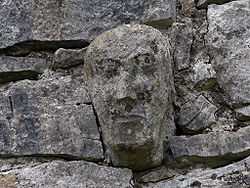Temple Cronan
| Temple Cronan | |
|---|---|
|
One of the carved stone faces in the walls of Temple Cronan | |
| Location | County Clare, Ireland |
| Coordinates | 53°2′47″N 9°3′40″W / 53.04639°N 9.06111°WCoordinates: 53°2′47″N 9°3′40″W / 53.04639°N 9.06111°W |
| Built | 12th century |
| Reference no. | 13[1] |
 Location of Temple Cronan in Ireland | |
Temple Cronan is a ruined medieval oratory or chapel built over a holy well in the Burren, County Clare, Ireland; the current buildings apparently date from the 12th and 15th centuries, although they may partly incorporate earlier buildings. Temple Cronan is located in the parish of Carran, eight miles from Corofin and about sixteen miles from Ennis, Ireland.[2]
History
Based on archaeological evidence, it has been concluded that Temple Cronan was built to serve as a pagan temple.[2] Archaeological evidence shows that the building had a window on the eastern wall as well as a small "Cyclopean" doorway on the west side of the building,[2] which is currently blocked by rubble. More conventional archaeologists see a 12th-century building, perhaps replacing one founded by one of the two much earlier Saint Cronans, one of Roscrea, who died in 640, and Cronan Mochua, who died in 637.[3][4] There are Romanesque carved stone human and animal heads at irregular points along the wall as decoration, several apparently not in their original location.[2][5][6] Some parts of an older construction, such as part of a doorway, may have been reused in 12th century construction.[2] In the twelfth century Temple Cronan was a site for pilgrimages. The building was most likely renovated again in the fifteenth century as is evidenced by a pointed door opening.[3][5]
Construction and building features
The oratory itself is a rectangular building 6.65 metres long and 3.91 metres wide. Because of its age, the high pitched roof, decorated with corbels at its corners,[7] has fallen apart, but the side walls and gables are still erect. The lower walls are made of limestone blocks.[3] The original door on the west side of the oratory is blocked by rubble,[3] and the current entrance to the oratory is located on the north wall. This door, probably constructed in the fifteenth century during the second renovation, is topped by a carved stone head.[5] It is likely that much of the building material was obtained from a nearby quarry.[5] The building consists on a one-roomed oratory, with two tomb shrines, constructed of two slabs of stone,[7] on the east side of the building, probably built in the twelfth century and possibly the destination of pilgrims travelling to the Temple Cronan.[3][5] To the south of the site is a holy well called Tobar Chronain,[5] most likely named after St. Cronan.[2] To the north there are ruins of several secular buildings, which most likely fulfilled non-religious duties for the monastery. Also to the north of the monastery is a quarry. It is from this quarry that much of the construction material used to build Temple Cronan and the other nearby buildings was gathered. In the northwest corner of the area, there is the remains of a large stone high cross "of considerable height" and its pedestal, which probably marked the boundaries of the Temple Cronan grounds.[5]
References
- ↑ National Monuments in County Clare
- ↑ 2.0 2.1 2.2 2.3 2.4 2.5 Keane, Marcus (2005). The Towers and Temples of Ancient Ireland: Their Origin and History. Kessinger Publishing. p. 378. ISBN 978-1-4179-7556-3. Retrieved 5 September 2008.
- ↑ 3.0 3.1 3.2 3.3 3.4 "St Cronan, Temple Cronan, Clare". The British Academy and Tessa Garton. 8 April 2002. Archived from the original on 5 June 2008. Retrieved 5 September 2008.
- ↑ O'Laverty, James (1878). An Historical Account of the Diocese of Down and Connor, Ancient and Modern 5. J. Duffy. p. 121.
- ↑ 5.0 5.1 5.2 5.3 5.4 5.5 5.6 "Temple Cronan". The Burren Home Page. Retrieved 5 September 2008.
- ↑ "Temple Cronan Early Christian Church". Discover Ireland. Retrieved 5 September 2008.
- ↑ 7.0 7.1 "Temple Cronan". Irish Antiquities. Archived from the original on 6 June 2008. Retrieved 5 September 2008.
| ||||||||||||||||||||||
